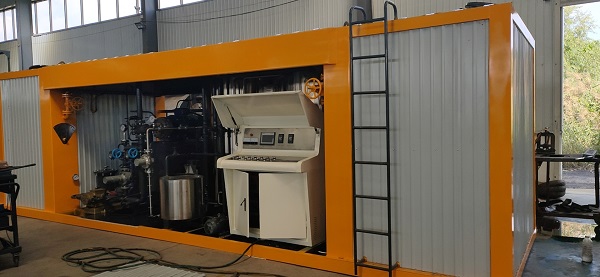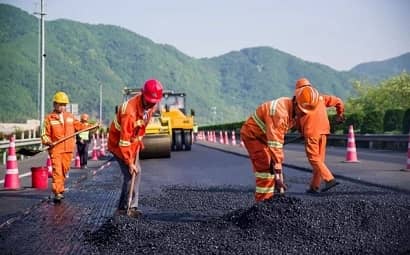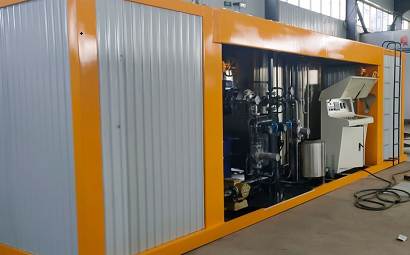The instability of emulsified asphalt manifests itself in three forms: flocculation, agglomeration and sedimentation. When emulsified asphalt particles break through the electrostatic repulsion of the double electric layer and gather together, it is called flocculation. At this time, if mechanical stirring is performed, the asphalt particles can be separated again, which is a reversible process. After flocculation, the asphalt particles that gather together combine into large-sized asphalt particles, which is called agglomeration. The agglomerated asphalt particles cannot be separated by simple mechanical stirring, and this process is irreversible. With the continuous increase of agglomerated particles, the particle size of asphalt particles gradually increases, and the large-sized asphalt particles settle under the action of gravity.

In order to ensure the stable storage of emulsified asphalt, it is necessary to prevent the three types of instability of emulsified asphalt: flocculation, agglomeration and sedimentation.
1. Prevent flocculation and agglomeration
In order to prevent the flocculation and agglomeration of emulsified asphalt particles, it is necessary to use emulsifiers scientifically and rationally first, and give full play to the chemical effect of emulsifiers.
The van der Waals attraction that commonly exists between substances will cause the asphalt particles to tend to approach each other. In order to prevent the asphalt particles from agglomerating, the interfacial film formed by the emulsifier molecules on the surface of the asphalt particles must be relied on. Based on this, the following technical measures can be taken to enhance the storage stability of emulsified asphalt.
(1) Ensure sufficient emulsifier dosage. After adding surfactants-emulsifiers to the asphalt/water system, they must adsorb on the interface to form an interfacial film while reducing the interfacial tension. This film has a certain strength and protects the asphalt particles, making it difficult for them to merge after collision. When the emulsifier concentration is low, the strength of the interfacial film is small, and the stability of the emulsified asphalt is naturally poor. When the emulsifier dosage is increased to a certain level, the strength of the interfacial film will be relatively large, and the stability of the emulsified asphalt will be relatively ideal.
(2) Use mixed emulsifiers. It has been found that the composite film formed by mixed emulsifiers has higher strength than the interfacial film formed by single emulsification, is not easy to break, and the emulsion formed is more stable.
(3) Increase the charge strength of the asphalt particles. Ionic emulsifiers can charge the surface of asphalt particles. When asphalt particles are close to each other, the electrostatic repulsion between like charges can resist the van der Waals attraction and prevent the asphalt particles from merging. Therefore, the stronger the charge of the asphalt particles, the better the storage stability of the emulsified asphalt. For cationic emulsified asphalt, the charge strength of the asphalt particles can be increased by lowering the pH value of the soap solution.
(4) Increase the viscosity of the emulsified asphalt. Increasing the viscosity of the emulsified asphalt can reduce the diffusion coefficient of the asphalt particles and reduce the collision frequency and agglomeration speed, which is beneficial to the stability of the emulsified asphalt.
(5) Mechanical stirring during storage. After the emulsified asphalt flocculates, mechanical stirring can be used to separate the close asphalt particles to avoid agglomeration.
2. Preventing sedimentation
In order to prevent the sedimentation of emulsified asphalt particles, the following aspects can be taken to solve the problem.
(1) Increase the particle fineness of emulsified asphalt and improve the distribution of asphalt particles. The size and distribution of asphalt particles in emulsified asphalt have a great influence on the stability of emulsified asphalt. The smaller the particle size of asphalt particles, the narrower the particle size distribution range, and the better the stability of emulsified asphalt.
In order to ensure the fineness of asphalt particles, it is necessary to select high-quality emulsification equipment, suitable emulsification process and emulsifier with good emulsification ability.
(2) Reduce the density difference between asphalt and water phase. The relative density of asphalt is different, and the sedimentation form of emulsified asphalt produced is also different. In general, emulsified asphalt particles settle in the direction of gravity; when the density of the water phase is less than the density of asphalt, the asphalt particles will "settle" upward. In actual production, some metal chlorides are added to the water phase to improve the stability of emulsified asphalt. One of its mechanisms is to reduce the density difference between asphalt and water.
(3) Increase the viscosity of the water phase and emulsified asphalt. The technical means are the same as described above.
 Albanian
Albanian  Russian
Russian  Arabic
Arabic  Amharic
Amharic  Azerbaijani
Azerbaijani  Irish
Irish  Estonian
Estonian  Odia (Oriya)
Odia (Oriya)  Basque
Basque  Belarusian
Belarusian  Bulgarian
Bulgarian  Icelandic
Icelandic  Polish
Polish  Bosnian
Bosnian  Persian
Persian  Afrikaans
Afrikaans  Tatar
Tatar  Danish
Danish  German
German  French
French  Filipino
Filipino  Finnish
Finnish  Frisian
Frisian  Khmer
Khmer  Georgian
Georgian  Gujarati
Gujarati  Kazakh
Kazakh  Haitian Creole
Haitian Creole  Korean
Korean  Hausa
Hausa  Dutch
Dutch  Kyrgyz
Kyrgyz  Galician
Galician  Catalan
Catalan  Czech
Czech  Kannada
Kannada  Corsican
Corsican  Croatian
Croatian  Kurdish (Kurmanji)
Kurdish (Kurmanji)  Latin
Latin  Latvian
Latvian  Lao
Lao  Lithuanian
Lithuanian  Luxembourgish
Luxembourgish  Kinyarwanda
Kinyarwanda  Romanian
Romanian  Malagasy
Malagasy  Maltese
Maltese  Marathi
Marathi  Malayalam
Malayalam  Malay
Malay  Macedonian
Macedonian  Maori
Maori  Mongolian
Mongolian  Bengali
Bengali  Myanmar (Burmese)
Myanmar (Burmese)  Hmong
Hmong  Xhosa
Xhosa  Zulu
Zulu  Nepali
Nepali  Norwegian
Norwegian  Punjabi
Punjabi  Portuguese
Portuguese  Pashto
Pashto  Chichewa
Chichewa  Japanese
Japanese  Swedish
Swedish  Samoan
Samoan  Serbian
Serbian  Sesotho
Sesotho  Sinhala
Sinhala  Esperanto
Esperanto  Slovak
Slovak  Slovenian
Slovenian  Swahili
Swahili  Scots Gaelic
Scots Gaelic  Cebuano
Cebuano  Somali
Somali  Tajik
Tajik  Telugu
Telugu  Tamil
Tamil  Thai
Thai  Turkish
Turkish  Turkmen
Turkmen  Welsh
Welsh  Uyghur
Uyghur  Urdu
Urdu  Ukrainian
Ukrainian  Uzbek
Uzbek  Spanish
Spanish  Hebrew
Hebrew  Greek
Greek  Hawaiian
Hawaiian  Sindhi
Sindhi  Hungarian
Hungarian  Shona
Shona  Armenian
Armenian  Igbo
Igbo  Italian
Italian  Yiddish
Yiddish  Hindi
Hindi  Sundanese
Sundanese  Indonesian
Indonesian  Javanese
Javanese  Yoruba
Yoruba  Vietnamese
Vietnamese  Hebrew
Hebrew  Chinese (Simplified)
Chinese (Simplified)






